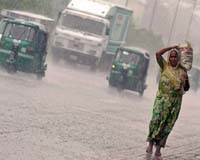 |
Having endured the lethal billow of methyl isocyanate gas which seeped from the Union Carbide plant on December 3, 1984, Jyoti and her contemporaries then suffered the stigma of being survivors.
"No one would marry her," said her mother Sheela. "They looked at her health and saw how sick she was, and that she was always going for treatment for her kidney and respiratory problems."
At just 39, Jyoti is practically a spinster by Indian standards, where despite increased educational and career opportunities, women are still pressured to marry young and reproduce soon after.
But the chances of a childless marriage or spending a fortune treating children with birth defects turned many Bhopal women into pariahs.
Research conducted by the state-run Indian Council of Medical Research (ICMR) until 1994 showed that 25,000 people had died from the consequences of gas exposure -- in addition to the 8,000 to 10,000 people who were killed within the first three days.
Government statistics compiled after 1994 concluded that at least 100,000 people living near the factory in central Madhya Pradesh state were chronically sick, with more than 30,000 residing in areas with contaminated water.
According to the ICMR, the number of still births and miscarriages increased immediately after the disaster, and activists say more than 350 tonnes of toxic waste strewn around the site still pollute soil and groundwater in the area, leading to hormonal and fertility disorders and other illnesses.
"My daughter has been married for more than five years and she still has no children," lamented 60-year-old Savra Bi, who lives in a crude row of shacks close to the plant, in the old part of Bhopal which was worst hit.
"After 1984, for 10 years no girl had a good marriage," agreed Champa Devi Shukla, a managing trustee with the Chingari Trust, which provides medical care to children with gas-related congenital deformities.
"Men thought they might miscarry. Even men in the new part of the city refused to marry them






No comments:
Post a Comment